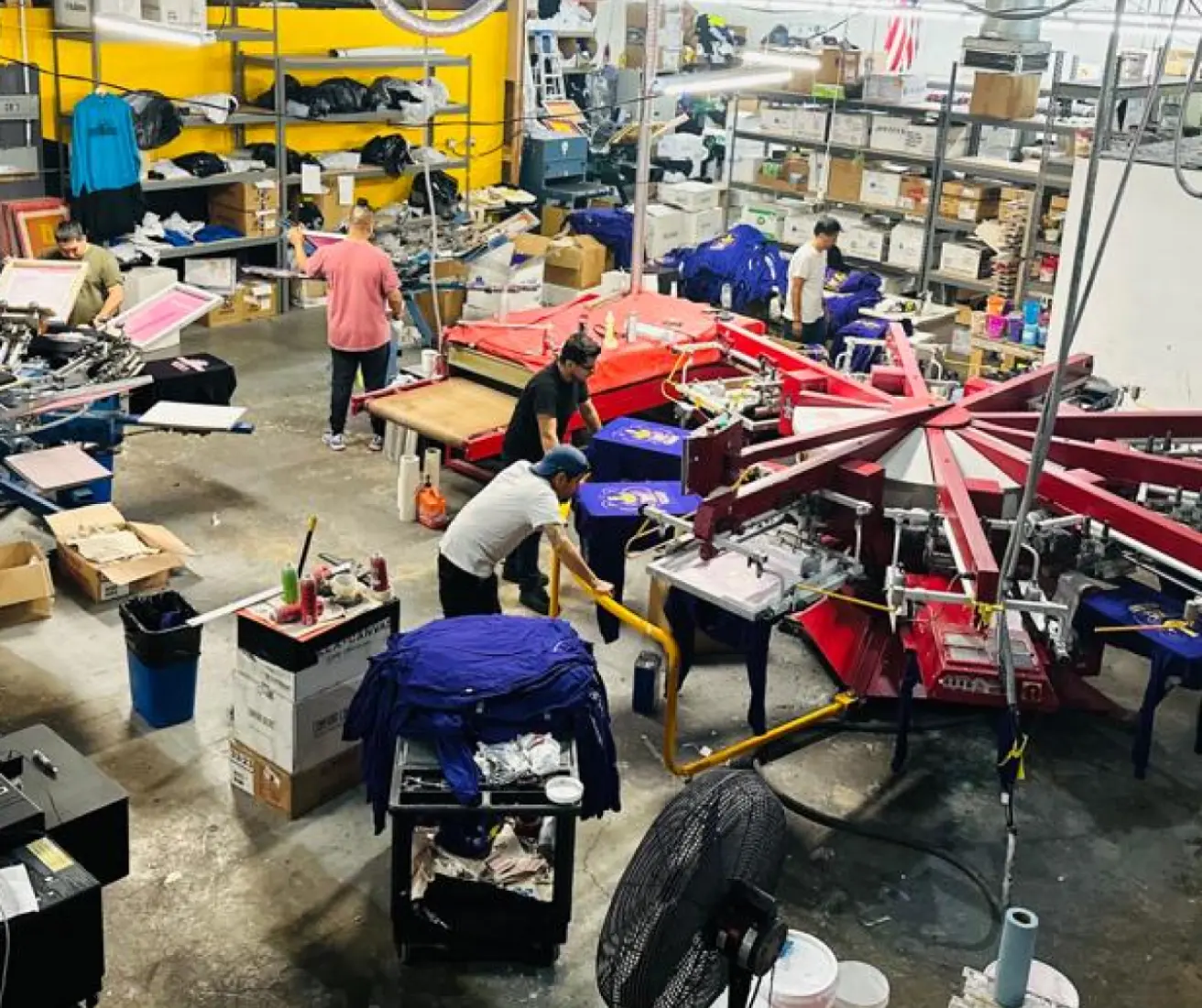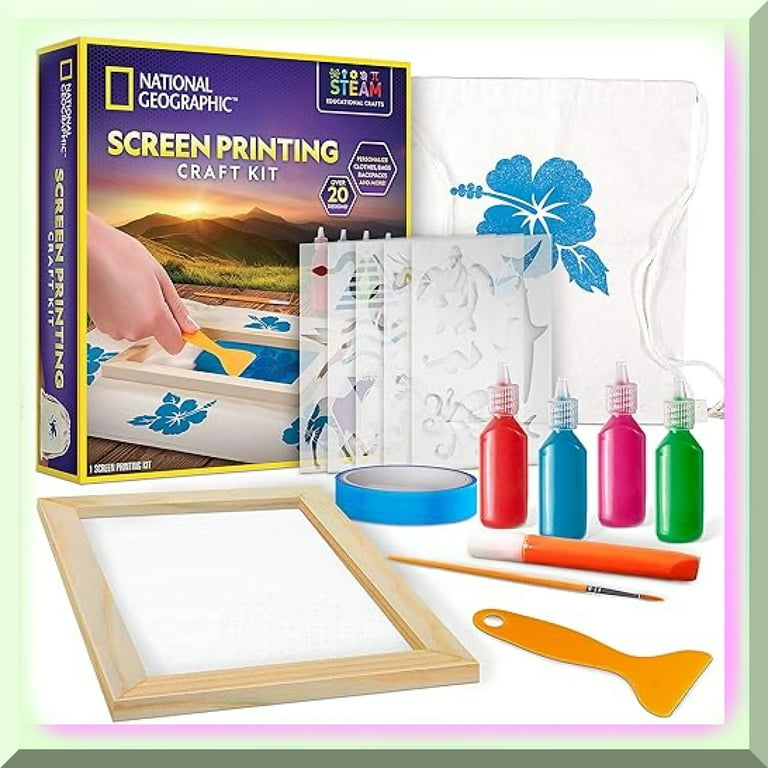Premium Screen Printing Kit for Business Startups
Wiki Article
Screen Printing Uncovered: Whatever You Need to Learn About Tee and Garment Printing Methods
Display printing is a fascinating technique that incorporates art with technique, offering limitless opportunities for creativity. Ready to check out the vital elements that make screen printing an art type?
The Basics of Display Printing: Just How It Functions
When you dive into display printing, you'll find it's both a scientific research and an art. At its core, display printing involves developing a pattern, or screen, that permits ink to pass through just in certain areas.Following, you'll mix your inks and prepare your printing surface. Position the display over the fabric, after that make use of a squeegee to press ink through the screen onto the garment. This process calls for accuracy, as you want clear, dynamic prints. After printing, you'll heal the ink with heat, ensuring it follows the textile and lasts via laundries. Each step is essential, and mastering them will certainly elevate your display printing skills, transforming straightforward garments right into distinct, expressive items.
Sorts Of Screen Printing Methods
When you understand the basics of display printing, it's time to explore the different techniques that can elevate your designs. One popular method is traditional screen printing, where ink is pressed with a stenciled screen.If you're aiming for fine information, take into consideration discharge printing. This method gets rid of dye from the fabric, leaving a soft, classic appearance. One more option is plastisol printing, recognized for its resilience and vibrant colors, making it a preferred for numerous brands. Experiment with halftone printing to create gradient effects and detailed styles. Each strategy has its special charm, so don't hesitate to attempt them out to locate what matches your design best!
Essential Equipment for Display Printing
To accomplish sensational outcomes in display printing, having the best tools is essential. Initially, you'll require a durable display printing frame, which holds the mesh that transfers your layout onto the garment. Next off, buy high-grade mops; these are essential for applying ink evenly across the display. You'll also require an excellent exposure unit to produce your screens, in addition to a washout cubicle for cleansing them after usage. A trustworthy heat source, like a conveyor dryer or warm press, is critical for curing your prints to ensure long life. Do not forget an appropriate workspace, furnished with tables and storage space for your materials. Finally, safety gear, such as gloves and masks, will maintain you risk-free from chemicals and inks. With the right devices, you'll be well on your way to generating professional-quality prints.Picking the Right Inks and Materials
When selecting inks and products for display printing, you require to consider the sort of ink that works best for your job. Consider textile compatibility to guarantee your styles look last and excellent long. Discover green ink alternatives to make your printing procedure extra lasting.Kinds of Display Inks
Selecting the ideal display ink is crucial for accomplishing vivid, durable prints that satisfy your task's demands. There are numerous sorts of display inks to take a look at. Plastisol ink is prominent for its convenience and ease of usage, giving excellent shade opacity on dark textiles. Water-based ink, on the other hand, uses a softer feeling and is eco-friendly, making it optimal for those wanting to lessen their environmental effect. Release inks eliminate color from the fabric, leading to a soft, classic look but require specific handling. Specialty inks, such as metal or glow-in-the-dark, can include unique impacts to your designs. Evaluate your task needs and select the ink that lines up best with your wanted end result.
Fabric Compatibility Considerations
Comprehending fabric compatibility is important for accomplishing high-quality screen prints, especially since different materials respond uniquely to numerous inks. Always examine your inks on example fabric to ensure they stick effectively and preserve shade integrity. Furthermore, keep in mind that material weight and appearance can affect the final outcome, so choosing the ideal ink and product combination is vital for your job's success.Eco-Friendly Ink Options
Environment-friendly inks are ending up being a popular option for display printers that desire to decrease their environmental impact while preserving quality. When picking inks, think about water-based inks, which are less hazardous and much easier to cleanse up compared to traditional solvents.In addition, try to find inks made from renewable energies, such as soy or vegetable-based choices. By choosing the right inks and products, you'll not only create stunning styles however also add to an extra lasting printing process. Make the button, and your prints will certainly show your dedication to the setting!
Preparing Your Layout for Screen Printing

File Layout Requirements
To ensure your style looks sharp and vivid on textile, you'll require to pay attention to file layout requirements for screen printing. Begin with vector data like AI or EPS, as they can be scaled without shedding top quality. If you utilize raster images, choose high-resolution data, such as TIFF or PNG, ideally at 300 DPI. Stay clear of using JPEGs, as they can shed clarity when resized. Make certain your layout has a clear background to avoid undesirable white edges on your prints. Keep shade modes in mind; CMYK is typical for screen printing, so transform your RGB develops as necessary - screen printing kit. By adhering to these standards, you'll establish your art work up for an effective print.Shade Separation Methods
Color splitting up is an important step in preparing your layout for display printing, and grasping it can significantly enhance your print high quality. You'll need to damage your style right into private shades, as each shade needs a different screen throughout printing. This accuracy not only assures accurate shade representation but likewise simplifies the printing process.Resolution and Dimension
Accomplishing the very best cause display printing begins with ensuring your design has the ideal resolution and dimension. Preferably, your art work should go to the very least 300 DPI (dots per inch) for sharp, clear prints. If you utilize reduced resolution, your last item could look amateur and pixelated.When it pertains to size, think about the dimensions of your print location. Style your art work to match the final print dimension, preferably producing it in the actual measurements you'll be publishing. In this manner, you'll avoid any unforeseen scaling issues.
Always examine your layout in both vector and raster formats. Vector graphics can be scaled without shedding top quality, making them excellent for display printing. Preparing correctly will guarantee your design looks fantastic on every garment!
Step-by-Step Display Printing Process
Display printing is a vibrant procedure that allows you to create dynamic styles on different surfaces. To begin, you'll need a display, emulsion, and your chosen ink. First, prepare your screen by cleansing it thoroughly. Next off, apply the solution evenly and let it completely dry in a dark location. When completely dry, expose your display to light with your style positioned on it, which will harden the emulsion where the light hits, developing a stencil - screen printing kit.Put ink onto the display and use a squeegee to press the ink via the stencil onto the textile. Lift the display meticulously and allow the print completely dry. You've effectively display published your layout.
Tips for Successful Display Printing Projects
While you're diving right into your screen printing projects, remember that prep work is crucial to success. Start by gathering all your products-- inks, garments, screens, and squeegees. A clean work area assists avoid undesirable mistakes, so tidy up before you begin.Following, verify your artwork is high-resolution and effectively sized for your garment. Evaluate your display for proper direct exposure and tidy it completely to stay clear of smudges. When mixing your inks, comply with the manufacturer's guidelines to accomplish the appropriate consistency.
During printing, use also stress with your squeegee for consistent outcomes. Do not rush; take your time to verify each print satisfies your criteria. After printing, let your garments completely dry totally before handling or packaging them.
Finally, constantly maintain an example of your work for future reference. In this manner, you can analyze your progression and improve your techniques in time. Delighted printing!

Often Asked Concerns
For how long Does It Take to Establish a Screen Printing Job?
Establishing a screen printing work normally takes about half an hour to an hour. You'll prepare the displays, mix inks, and readjust the press. The time varies based upon complexity and experience, so stay arranged!Can I Publish on Different Fabric Types Using the Very Same Strategy?
Yes, you can print on different fabric kinds making use of the exact same technique, yet you'll need to adjust your inks and settings. Some fabrics soak up ink differently, so trying out warranties the finest results for each material.What Are Usual Blunders to Stay Clear Of in Display Printing?
When screen printing, stay clear of common mistakes like using the wrong ink, disregarding proper exposure times, or missing pre-press checks. Always examine your configuration and preserve tidy screens to assure top quality outcomes each time.Exactly How Can I Appropriately Tidy and Maintain My Screen Printing Devices?
To properly clean and preserve your screen printing equipment, you need to regularly wash displays with appropriate solvents, examine mops for wear, and assure all devices are saved dust-free and completely dry. Uniformity avoids pricey repair work and enhances efficiency.Is Screen Printing Eco-friendly Compared to Other Methods?
Display printing can be a lot more eco pleasant than other techniques, specifically if you make use of water-based inks and eco-conscious materials. By picking lasting supplies and methods, you lower waste and reduce your effect on the planet.Display Printing Uncovered: Whatever You Required to Know About Tee and Garment Printing Methods
garment printing At its core, screen printing entails developing a pattern, or display, that permits ink to pass via just in particular locations. Placement the screen over the textile, then utilize a squeegee to press ink through the display onto the garment. One preferred technique is standard screen printing, where ink is pressed via a stenciled display.When selecting inks and materials for screen printing, you require to take right into account the kind of ink that works finest for your job.
Report this wiki page